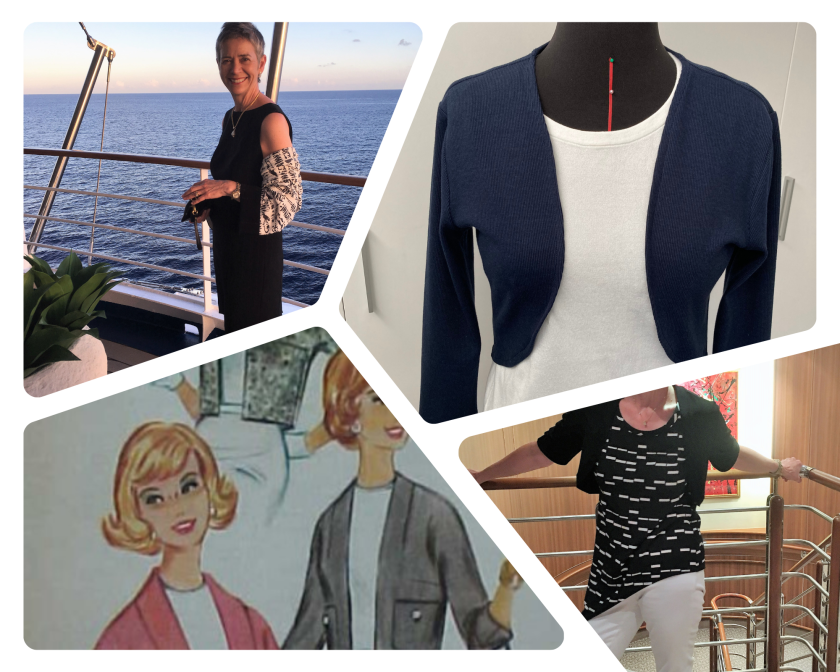I think that the shrug might just be the most useful piece of clothing a woman could own. They are so small, so light, so packable. Well, most of them are. The shrug. Sometimes referred to as a bolero. But are they the same thing? I’ll get to that, but let me begin by introducing you to the shrug.
I’d like you to meet a few shrugs I’ve known and loved in my life.






[FYI: I used McCall’s 7289, which now seems to be out of print ―for good reason in my view―for the white and black shrug shown on the veranda of a cruise ship suite, but it was so humongous and funky, I had to make a significant number of changes to the pattern.]




So, how exactly do you define a shrug?
Well, the English language is a funny bird, isn’t it? The Merriam-Webster dictionary says to shrug means “to raise or draw in the shoulders especially to express aloofness, indifference, or uncertainty.”[1] And a shrug is the act of shrugging.

Ah, the English language. A shrug is also a piece of clothing. No wonder so many people have difficulty learning the language!
Wikipedia, the arbiter of all things, says, “A shrug is a cropped, cardigan-like garment with short or long sleeves cut in one with the body, typically knitted, for women.”[2] Hmm…that doesn’t seem quite right. It seems too narrow. In fact, many online definitions on supposed style sites suggest that they are knitted garments, and when they are embellished, they are boleros. However, that doesn’t make sense to me, given the origin of the bolero and shrug.
If we look at the evolution of fashion historically, it seems that the bolero jacket evolved from a military garment called a Zouave jacket, a garment that is not, in any way, knitted. It was widely used in uniforms during the nineteenth century and even earlier, especially during the American Civil War.

If you think about the fashions in Gone with the Wind, for example, and consider the jackets often worn over those voluminous dresses, you are seeing the evolution of the Zouave jacket into what we now refer to as a bolero, which has Spanish origins. Think bullfighter. So, the two similar garments come together to give us what we see today as bolero jackets. But are these shrugs?

I’ve concluded that I have to have my own definition that arises from all of this, so here’s what I’m going with.
A shrug is a short, cropped jacket that is worn open over the bodice of a dress, top or T-shirt.
A shrug sweater is a knitted shrug.
A bolero jacket is a shrug that may or may not be slightly longer but that always has a closure at the front.
How’s that? Anyway, those are my definitions and I’m sticking with them. Now that we have that out of the way, why would you even need one (or a dozen) shrugs? Here are my reasons:
- Shrugs flatter every body type.
- A shrug can change the look of any dress, top or T-shirt.
- You can wear a shrug to a soccer game or a black-tie event.
- A shrug can make one dress or top endlessly versatile.
- Taking three little, tiny shrugs on vacation can make one dress have four looks! (Includes the look without a shrug.)

It also seems that people have been sewing shrugs for decades. One of the vintage patterns I was drawn to and had to own is McCall’s 5337 from 1960. I haven’t made this one yet, but I will.


And here are a few more from the 1940s and 1950s.


Lest you think that shrug/bloero patterns are only an historical artifact, there are oodles of current patterns for these nifty little items. Here are a few to consider:



Recently, I had a piece of leftover ottoman ribbed bamboo fabric that I knew I should use. I paid twenty or twenty-five dollars a metre for it, so I had to use it. But what could I make? What did I have enough of it to make was the more important question.
Last year I made a knit jacket from McCall’s 7254. It has a view that when you leave off the collar and front, you’re left with a tiny shrug. It was perfect, and I managed to squeeze out enough fabric to make it. Of course, it was dead simple to make. In fact, it took so little time, I was disappointed, given my penchant for slow sewing! There was only so slowly I could go.


Now, I have a new shrug to pair with a simple white T-shirt in the spring, or perhaps even over a little dress. Although the process was quick, during it, I also discovered something interesting.
One indie pattern company that seemed to have several interesting designs for shrugs and bolero jackets was Lekala. The next time I post, I’ll tell you about my experience of falling down that particular rabbit hole.



Do you own shrugs?
FYI

I found lots of free shrug/bolero patterns online―many were hopeless. Here are three that might work:
http://so-sew-easy.com/free-shrug-pattern-simple/#_a5y_p=3122814
https://www.sewmag.co.uk/free-sewing-patterns/floral-bolero-jackethttps://www.moodfabrics.com/blog/the-gordonia-hoodie-free-sewing-pattern/


I have just found your blog, and want to thank you for the wonderful information and ideas. I too am a woman of a certain age who sews, albeit not a lot. You are a rare find and I am so looking forward to getting more ideas from you. Thank you!
LikeLiked by 1 person
So happy to have you along on my journey here! Stay tuned for lots of stories! P (aka GG)
LikeLike